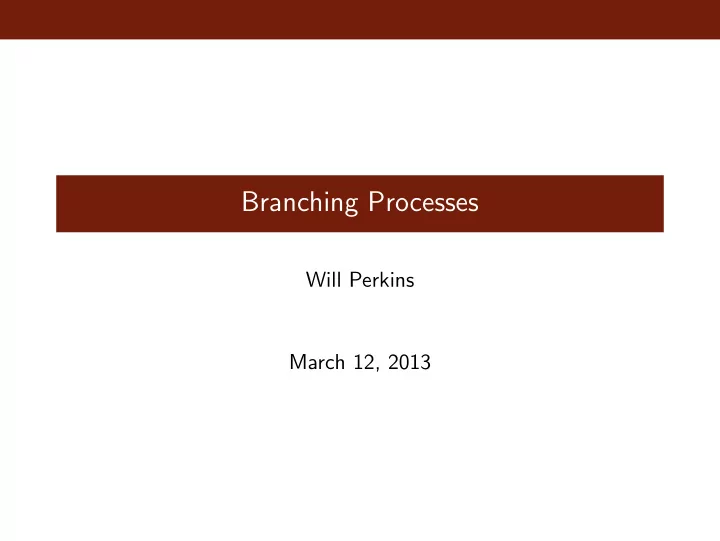

Branching Processes Will Perkins March 12, 2013
Galton and Watson In 1873 Francis Galton wrote an article asking for an understanding of how family names in England would go extinct. A year later, Henry William Watson gave a mathematical solution and together they wrote a math paper introducing the mathematical frameowrk of the branching process . Branching processes can be used to model: Philogenetic or family trees Atomic Chain Reactions BFS in a network Epidemics Rumor spreading
Galton-Watson Process Definition Let µ be a distribution on the non-negative integers. A Galton-Watson process with offspring distribution µ is a stochastic process with Z 0 = 1 and Z n = X n , 1 + X n , 2 + · · · + X n , Z n − 1 where the sum is Z n − 1 independent rv’s each with distribution µ . We think of Z n as the number of individuals in generation n .
Markov Property Exercise: Prove that Z n is a homogeneous Markov Chain. Which states are recurrent? Which are transient?
Extinction A branching process ‘goes extinct’ if Z n = 0 for some n . We say a branching process ‘survives’ if it does not go extinct.
Warm-up Say the offspring distribution has mean λ . What is E Z n ? Use conditioning. E Z n = E [ E [ Z n | Z n − 1 ]] = E [ λ Z n − 1 ] = λ E Z n − 1 Then repeat the trick n − 1 more times. E Z n = λ n
Extinction Probability Show that if λ < 1 then the branching process goes extinct with probability 1.
Extinction Probability What if λ = 1 or λ > 1?
Extinction Probability Let y be the probability that a given branching process goes extinct. Let p k Pr[ X = k ], the probability that one individual has k offspring. Then: ∞ � p k y k y = k =0 Why? This looks familiar: y = G x ( y ) The Generating Function of the offspring distribution!
Extinction Probability So we want to solve y = G X ( y ). There’s always one solution to this equation: y = 1. But is that the only solution? [Plot of a Poisson distribution with different means]
Extinction Probability What conditions on the offspring distribution imply there are multiple solutions? Which solution is the correct extinction probability?
Extinction Probability Draw a picture and use Taylor’s Theorem. G X (1) = 1 G ′ X (1) = E X G X (0) = p 0 This shows that if E X > 1 then there are multiple solutions. If E X < 1, there is only the single solution y = 1. If E X = 1, there is a single solution as long as p 0 > 0 (and if not, we know the branching process is just Z n = 1 for all n ).
Extinction Probability So it remains to determine which of the solutions is correct for E X > 1. We start by computing the generating function of Z n : G Z 1 ( s ) = G X ( s ) G Z 2 ( s ) = E s Z 2 = E [ E [ s Z 2 | Z 1 ]] = E [ G X ( s ) Z 1 ] = G X ( G X ( s ))
Extinction Probability And iterating, G Z n ( s ) = G X ( G X ( · · · G X ( s ))) Let y n = Pr[ Z n = 0]. Then 1 y n is increasing in n 2 y n → y as n → ∞ 3 y n = G X ( G X ( · · · G X (0)))
Extinction Probability Theorem The probability of extinction of a branching process is the smallest non-negative root of the equation: y = G X ( y ) Proof: We have seen that the extinction probability satisfies the equation. Let γ be some non-negative root of the equation. We claim that y ≤ γ .
Extinction Probability y 1 = G X (0) ≤ G X ( γ ) = γ since G is a non-decreasing function. y 2 = G X ( y 1 ) ≤ G X ( γ ) = γ and so on.. y n ≤ γ for all n , and since y n → y , we have y ≤ γ completing the proof.
Recommend
More recommend